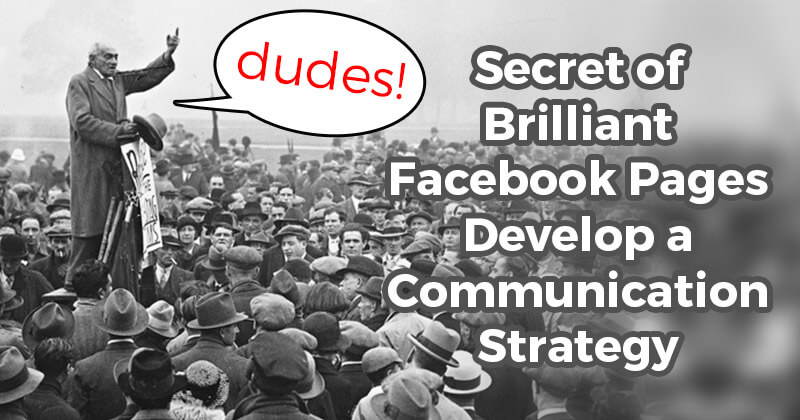
 The title of this blog post alone scares me!!
The title of this blog post alone scares me!!
"Develop a Communication Strategy" ???
It sounds so technical & detailed that I'm a bit scared to even write this post!
But I think it's crucial -- and it's easier than you think!
Recently I sat down with my pastor because I want to help our church communicate better.
Right now the church has been using a few tools:
- website
But the messaging is all over the place & lacks purpose.
I'm volunteering my time to head up social media, the website & general communication because the church is growing & I want things to be under control before it gets out of hand.
At about 100 people we can get away being a tad unorganized, but once we reach 300+ it will be a problem.
We were about to embark on using MailChimp & another membership database, but I felt we needed to stop first & focus on the reason we're using the tools.
Developing a Communication Strategy
The process of developing your strategy is similar for every business -- although the outcomes will be vastly different.
How a large Fortune 100 company communicates is vastly different than how a local burger joint with 3 employees communicates.
But they both still need to have a strategy -- otherwise they'll have chaos.
I want to break this down into 3 Questions you need to ask yourself about your business.
*It's crucial that you do these questions in order or you will not have a viable strategy.
 Question 1: Why do I need to Communicate?
Question 1: Why do I need to Communicate?
Before you start a Facebook page, Twitter account, website or email newsletter you must determine WHY you are doing it!
What is the purpose of the communication?
Are you wanting to increase sales? Get more members? Promote an event? Raise awareness on an issue?
Oftentimes a business will start using multiple platforms to communicate but have no clear reason why they're doing it.
Someone told them they should have a Pinterest account but they don't know why!
If you're a business with multiple partners or managers, I'd recommend having everyone sit down & write out the "why".
I'd bet each person has a different "why" motivating their ideas.
For our church we decided our 2 "whys" were:
- To keep members informed
- To let people know who we are (branding)
It's imperative that your team agree on what "whys" you'll focus on.
You might even consider prioritizing each why & then focusing on one at a time -- as you find answers to the next 2 questions.
 Question 2: Who am I trying to Communicate to?
Question 2: Who am I trying to Communicate to?
Sounds like an easy question to answer, right?
You want to communicate to everyone, right?
Wrong.
You need to identify the different groups of people you're targeting when you make a post on Facebook, tweet or send an email.
Let's use my church for example.
We determined that we had a few different groups of people we wanted to communicate to:
- Members
- Prospective Members -- People who have visited the church & want more information
- Potential Visitors -- People who have never visited the church
- Our Community (this included members who may have moved or people who are connected to us but not in our town. We also included members of other churches & pastors here because they need to know about our church but aren't people we target as guests or members)
Once we created these 4 groups (originally it was only 3 -- but we decided to split the prospective members group into 2) we decided to rank them in importance. That order is reflected above.
The order of importance is crucial because it will determine your priorities & where you focus time & energy.
Hopefully you're starting to see how you can use this process for your business to determine who you're trying to communicate to.
Knowing this information will completely change how you communicate because it will give you a priority & reasoning behind each blog, email, tweet or status update.
Let's use Facebook posts for an example.
Some posts will be directed at:
- your current customers
- fans who have tried your free trial but haven't bought yet
- people who maybe don't know much of anything about you
Again: List the groups you're communicating to & order them by importance.
Question 3: How am I going to Communicate?
 Now that you understand why you're communicating & who you're communicating to, you can determine how you will communicate to them.
Now that you understand why you're communicating & who you're communicating to, you can determine how you will communicate to them.
Step one is to take each group you identified above & then list the ways you want to communicate to them -- and then rank those items in order of importance.
Typical ways you will communicate are:
- Social Media
- Website
- Newspaper
- Radio
- TV
- Billboards
- Postcard
- Phone
- In store
Going along with the example of my church here is how it turned out:
Members:
- Church Bulletin
- Website
- Announcement Slides before service.
Prospective Members:
- Bulletin
- Announcement Slides before service
- Website
- Newspaper
- Postcard
- Phone call
Potential Visitors:
- Website
- Newspaper
Community:
- Newspaper
- Website
I listed these out to show you the diverse ways we want to communicate to each group -- and honestly I didn't expect such diversity before doing this exercise.
I expected the priority in how we communicated to be the same for each group -- but it wasn't.
This will likely be true for your business too -- regardless of the type of business you run.
Each group in your "Who" question will need to be communicated to using different methods.
Ideally people will transition from the last group to the 1st -- in the case of my church from Community to Potential Visitor to Prospective Member to Member.
We also realized that in order to be effective with our communication & not be redundant, we shouldn't waste people's time by telling them the same thing over & over. But we also needed to remember that others may not know this information yet.
It's a tough balance.
You also will need to figure out what's important enough to broadcast out & what isn't.
If the information is only relevant to half your audience or less, then you probably don't need to post it on Facebook.
*Example: Maybe your app had an outage for an hour & only a handful of people noticed. It wouldn't make sense to broadcast this to everyone as it only affected your members. So send an email only to members.
Make sense?
What's Your Next Step?
Now that you have answered these 3 questions & have a firm grasp of their answers, you should be able to build a communication strategy that:
- has structure
- makes sense for your organization

Your job now is to decide how you will use each tool (email, social media, website, etc.) to communicate in the different ways & to the different people you've identified.
The main mistake I want you to avoid is focusing on the tools instead of what you're going to do with the tools.
Always remembering what your WHY is!
*For you skimmers here are the 3 questions to ask when building a communication strategy:






No Comments